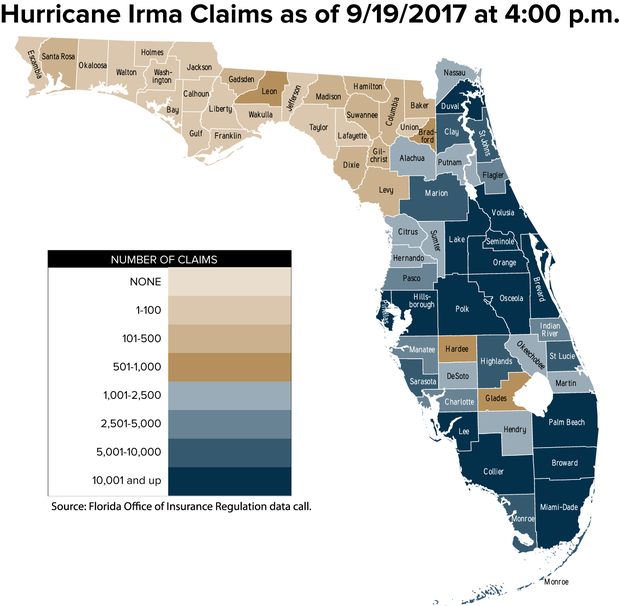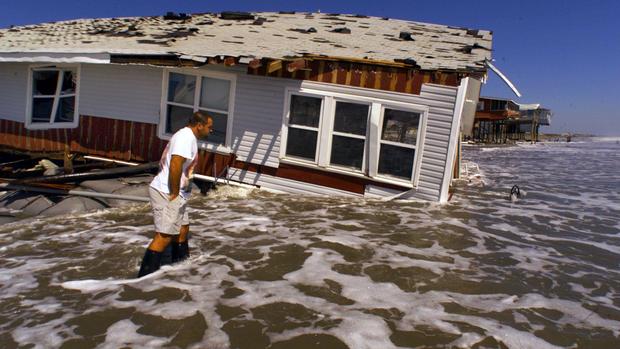How Much Will It Cost To Repair Hurricane Irma Damages
Rebuilding in Florida'southward Keys, at what cost?
Like pioneers in a wagon train, a long line of homeowners has crossed the bridges back down to the Florida Keys, determined to reclaim their homes from the ravages of Hurricane Irma. For almost, optimism is riding along.
Seeing their wrecked homes is their first dose of reality; the next will exist trying to rebuild. They'll face huge expenses, government regulations that are growing ever more stringent and an often-lengthy process of negotiation with their insurance company to decipher a clause-laden contract that doesn't ever provide what they thought it would.
That's the piece of cake function. Some people are advocating for the reverse, arguing that many homes on these low-lying "barrier islands" -- built by nature to absorb a hurricane'due south punch and not to pass it along to the mainland -- shouldn't be resurrected.
"People and communities should call back hard about whether to rebuild -- and where -- before they even get to the 'how,'" said Vice President Steve Ellis of Taxpayers for Common Sense, a nonprofit Washington, D.C.-based upkeep watchdog group.
He's not the but one. "We should seriously consider that there are some locations in the Florida Keys which can't be built on at all," said Robert Hartwig, co-director of the Eye for Take chances and Uncertainty Direction at the University of South Carolina. "Without long-term thinking, the Keys don't have a future. They'll be wiped out regularly."
With catastrophicHurricane Maria slamming Puerto Rico and now headed somewhere upward the Atlantic Coast, that may seem obvious. Only people tend to take short memories. So the lessons learned from the last series of major hurricanes -- Katrina, Rita and Wilma in 2005 -- may need to be relearned as mother nature butts heads with human nature. Merely earlier this year, a group of Florida Keys business leaders led the accuse against any increase in their insurance "windstorm rates," claiming they weren't "actuarially audio."
Indeed, near Floridians will try to rebuild their homes and businesses as before long as possible. But when they do, they'll come up face up to confront with the economic necessity of finding the coin, the claiming of doing it and finally -- and peradventure the biggest hurdle -- purchasing insurance all over over again.
This is what awaits those looking to rebuild. They'll realize that their insurance won't cover everything. Virtually every policy written in Florida includes a "hurricane deduction" of 2 percent to 5 percent. In essence, if the habitation y'all lost is valued at $400,000, you could pocket only $380,000.
Some insurers didn't even offering insurance for windstorm damage from Irma, transferring that adventure to state-run insurer Citizens Holding. Homeowners without that Citizens policy and who relied on traditional insurers for this type of coverage, could be in for a surprise.
The aforementioned is true for flood insurance, almost always a divide policy. Even though Irma was a 135-mile-per-hour windstorm hurricane, flooding was likewise a major issue. One estimate is that less than half of Florida's homeowners had such coverage.
This will cause a lot of wrangling for littoral property owners, where "tempest surge" -- waves and tides driven onshore by winds -- acquired a lot of damage. Insurers volition pay for a portion of that, simply they'll argue about the remainder, just as they did after Hurricane Katrina in 2005 past challenge that simple water damage isn't covered.
Those who do have coverage may find that it can take years to resolve claims, particularly when insurance adjusters and engineers minimize the damage, as they did after Superstorm Sandy in 2022. Many homes destroyed by Sandy are withal in the procedure of existence restored, partially because the banks that concur the mortgages on these backdrop are reluctant to release whatsoever money until they have bodily repair contracts in hand.
Thus far less than vii percent of Floridian homeowners' claims take been closed and far fewer commercial and mobile home claims, co-ordinate to the Florida Role of Insurance Regulation.
But getting the coin is only the start of the rebuilding procedure. How to spend it and whether there's enough of it comes next. Florida has some of the strictest building codes in the nation. As a bicoastal state, information technology's always susceptible to a double dial from hurricanes. These building codes, which were passed statewide in 2002, apply to structures built thereafter. Florida building inspectors will probable insist that homes being rebuilt accept to meet these codes.
It'due south not going to exist cheap. One judge past builders is that regulatory compliance could add almost 50 percentage to the toll of rebuilding, well beyond the likely insurance settlement. That could go even higher for the Florida Keys, where everything, including labor and structure materials, has to be brought in on the just highway.
In combination with this year's other hurricane disasters (and so far), Harvey and Maria, the cost of labor, plywood and conduit cable is likely to soar. Chief Executive Julie Rochman of the Insurance Institute for Business & Abode Prophylactic (IBHS), which researches ways to protect buildings against natural disasters, pegged the price of structure in Florida's Pinellas Canton, which includes Petrograd and bulwark islands, at $200 to $250 per square pes. That effigy was computed before Hurricane Irma. And the average American home is now 2,600 square feet.
Many communities, equally well as the Federal Emergency Direction Bureau (FEMA) itself -- which is picking upwards the tab for much of the cost of these hurricanes -- are likely to insist that reconstructed homes be raised on pilings to help forbid future flooding. This will require heavy construction crews and cranes.
Even partial repairs, such every bit shatter-resistant windows and storm shutters, can be expensive. For a full firm or roof rebuild, improve nails and tape could add 5 percentage to the full toll, said the IBHS.
When the house is rebuilt, the homeowner will notwithstanding take to buy insurance. And that won't be cheap, either. Property insurance in the Keys currently averages well-nigh $iv,000 per year. Florida Gov. Rick Scott has alleged a 90-twenty-four hours "freeze" on whatsoever increase in insurance rates, just the freeze isn't binding on the several insurers that have already requested rate increases, which range every bit high every bit 10 percent.
Many homeowners are likely to buy their coverage from state-run insurer Citizens Property, which by constabulary tin increase rates simply by ten percent a year. But Citizens, which already raised rates this year due to an inflated number of legal cases against information technology, can also charge an "assessment" to all types of Florida property owners, according to Hartwig of the Center for Risk and Uncertainty Management.
And then will insurance rates rise? Almost certainly, and what may be worse, payouts will autumn. Consumer advocates accept long complained about the clauses inserted into new contracts, such as the "hurricane deductible." And now these clause are likely to go more common fifty-fifty as the deductibles ascension.
Because inundation insurance rates are gear up so low, the National Inundation Insurance Program (NFIP) has lost billions of dollars for years, which could prompt Congress to turn some of the program over to private insurers. If this happens, consumer advocates say the price of coastal flood insurance will skyrocket.
States devastated by these 2022 hurricanes will enquire for and get at least $100 billion in federal aid, predicted Hartwig. But it volition have to be shared by Florida, Texas and Puerto Rico.
And and then there's the question of who gets the money? Does information technology go to remediation, such equally repairing the current storm damage, or to mitigation, making sure the side by side one doesn't do as much damage.
For people similar Hartwig and Ellis, the answer is clear: Information technology makes more sense to build seawalls, fortified pumping stations and tear down buildings that stand up in the way of the inevitable tide rather than gear up them again afterward. "Every dollar of mitigation saves y'all $6 in the long run," argued Hartwig.
Merely homeowners, businesses and builders in the Keys would certainly come across information technology differently. And they have a lot of clout, at least for now.
"Hurricanes are great teachers, but our ability to retain these lessons is spotty," said Lynne McChristian, a professor of insurance at Florida State University. "It seems that every 12 years or so we need a refresher form."
How Much Will It Cost To Repair Hurricane Irma Damages,
Source: https://www.cbsnews.com/news/hurricane-irma-florida-keys-homeowners-rebuilding-costs/
Posted by: allmanchatthould.blogspot.com




0 Response to "How Much Will It Cost To Repair Hurricane Irma Damages"
Post a Comment